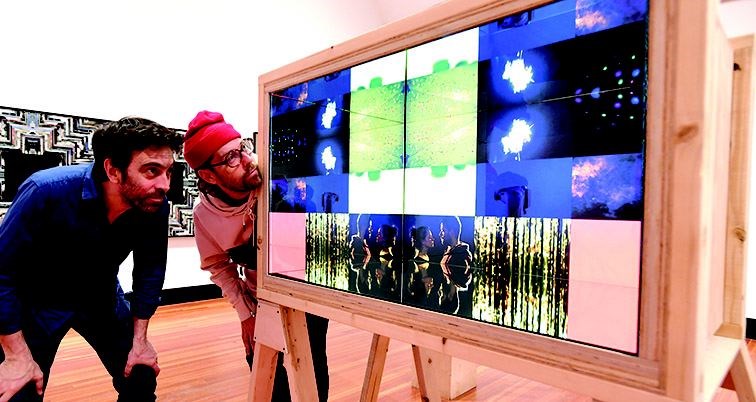If we are lost, sang Blue Rodeo, then we are lost together.
Society has tools now that allow for millions of people to be in unprecedented touch with each other, but those same tools also build figurative walls or incent us to stay within our actual ones. This junction in time is the basis for (Dis)Connected, the latest exhibition to open at Two Rivers Gallery.
"At the beginning of the 21st century, communication and other technologies ensure that we are more connected to each other than at any other time in human history," said gallery curator George Harris. "Yet, many have argued, we are paradoxically more disconnected from our shared humanity than ever before. This condition is the focus of artists whose work is collected here offering insights from a number of different perspectives."
The show is a group exhibition, with artwork created by combinations of solo and duo artists. The creator roster includes Jeroen Witvliet, Shawna Dempsey & Lorri Millan, Brendan Lee Satish Tang & Diyan Achjadi, and the team of Mathieu Doyon & Simon Rivest who usually work as a team. Doyon-Rivest is a well-known name(s) in the Quebec arts scene.
"It's our first show west of Toronto," said Rivest. A mutual friend of Harris's acted as intermediary to connect the duo with Two Rivers Gallery.
"It is open art, as much as possible - open for people's interpretations and imaginations," Doyon said. Rivet added, "to set the table for people's discussions. We want people to think about the computer, the smart phone, the social media without actually using those things in the art."
The public in Quebec City already got a close look at one of their showpieces on that theme. It is a film on a television screen of what looks to be a drive-in theatre showing a movie, but coloured lights flash inside all the assembled cars parked in their rows, and the eye soon detects that no one is in any of the cars. The automobiles themselves are reacting emotionally to the scenes on the screen.
"The drive-in is kind of an archetype of the American dream," said Rivest. "You are sitting in your car beside other people in their cars, all reacting to one source of input but disconnected and physically separated from each other. It is very analogous of what is happening right now with our screens held in our hands. We are connected by these devices like never before in human history, but we are alone with them, distracted from each other by them."
In Quebec City, the viewers got to walk among the actual cars in their actual makeshift drive-in. In Prince George, the viewers are seeing this installation art play out on yet another screen.
In another segment of Two Rivers Gallery, the duo has another piece that was so new that Doyon and Rivest were still constructing it on the spot the day the show opened. It is a box into which viewers put their head to see a TV screen at the far end. The screen shows a sequence of film clips and mirrors surround the box's interior to give the effect of infinite images - images of the screens and images of you as you enter their world.
"This whole piece is the first time we're showing it," said Doyon. "We had the video made but we didn't know what we were going to do with it, the thought wasn't formed until we came here. This is the first time ourselves that we get to see it."
The pair has other pieces of art in this exhibition as well, and each of them is a silent discussion of how modern technology has taken steps forward from past technologies in a progression of disconnection. This is all the more underscored by the two artists working together on installations that now stand alone to entertain and inform.
"Because we are two, the bright side of working together is we can work out ideas and question those ideas before it gets to the point of being in a gallery," said Rivest.
It's a helpful irony, in the case of this particular show, where the entire two-gallery showspace is devoted to the concept of a society at odds with human interaction. It is a rare occasion that both of the gallery's primary display rooms are used for one combined exhibition.
"Dealing with diverse concerns during fraught times, these artists examine various points of disconnection within their photographs, paintings, video and installation-based work," said Harris, describing the exhibition as a whole. "Doing so they embody the human impulse to connect with others and remind us of what it is to be human at a time when it seems too easily forgotten."
Harris brought in Rivest and Doyon who are a career duo, but he also created a connection for some of this show. He explained that "normally independent artists Diyan Achjadi and Brendan Lee Satish Tang have collaborated to produce Residue: Tracing the Lore, a series of photographs that explore the transmission of traditions through generations and the enduring legacies that remain with us."
Another pair working together, Shawna Dempsey and Lorri Millan, were pulled by Harris right out of cyberspace into the tactile world. Their piece Consideration Liberation Army was, said Harris, "originally a web-based project but reprised here as an installation, calls for thoughtful acts and respectful deeds where civility is often lacking."
The final participant is someone with a dual background. Born in the Netherlands and now living in Canada, Jeroen Witvliet's work in this exhibition speaks, said Harris, of "connections to place, the self and others as a way of investigating different forms of belonging."
The show is on at Two Rivers until July 7.



